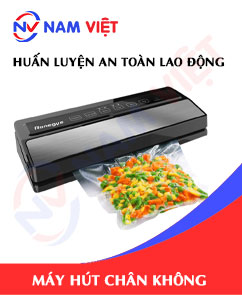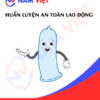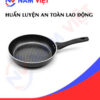Occupational Safety Training in Vacuum Pump Manufacturing
99,000 ₫
Note: The above price is calculated for one person, the price may fluctuate depending on the number of trainees participating in the course and depending on market movements. For more accurate pricing support, please refer to the quotation table or contact our consulting staff directly.
Occupational safety is an important issue in vacuum pump manufacturing factories and needs to be addressed promptly to ensure the health and safety of workers, and to enhance the reputation of businesses. The Occupational safety training course is one of the effective solutions to raise awareness about accident prevention for workers participating in vacuum pump manufacturing.
Table of Contents
Toggle1. Overview of Vacuum Pumps
a. What is a Vacuum Pump?
A vacuum pump is an industrial device used to create a vacuum environment within a container or a specified space. The vacuum pump works by removing gas molecules from the space, generating a pressure lower than atmospheric pressure.
This rarefied environment is applied in many industrial processes, including food processing, packaging, pharmaceutical production, electronics, scientific research, and the manufacture of machinery and industrial equipment. Vacuum pumps are typically equipped with gas filters to remove dust and moisture to ensure the highest quality of vacuum air possible.

b. Types of Machinery Used in Vacuum Pump Manufacturing
The vacuum pump manufacturing process usually involves multiple steps, each requiring specific machinery. Some common machines used in vacuum pump production include:
- Metal cutting and processing machines: These machines are used to cut, polish, and process metal to create key components of the vacuum pump, such as containers, compressors, pump heads, and other parts.
- Welding machines: Used to weld metal parts together to form containers, pumps, and other components.
- Grinding and polishing machines: For producing containers and other parts with high precision, grinding and polishing machines are used to refine metal components.
- Mechanical machines: Machines such as lathes, milling machines, and drills are used to shape the components and parts of vacuum pumps.
- Casting machines: Casting machines are used to mold metal parts into the required shapes and sizes for vacuum pump components.
- Inspection machines: These are used to check the quality of vacuum pump components to ensure they meet required standards.

c. Vacuum Pump Manufacturers in Vietnam
Some well-known vacuum pump manufacturers in Vietnam include:
- Khoa Nguyen: A brand specializing in vacuum pumps, compressors, and related products. Their products are widely used in industries such as manufacturing, food processing, pharmaceuticals, electronics, and mechanical engineering.
- A Chau: A reputable brand in vacuum pump manufacturing, applied in food production, packaging, printing, aquaculture, pharmaceuticals, chemicals, and essential oils.
- VinaTAB: Specializes in vacuum pumps, compressors, and related products, recognized for quality, after-sales service, and reasonable pricing.
- Hong Ky: A trusted brand in vacuum pump manufacturing, widely used in production, processing, and distribution of food, pharmaceuticals, electronics, and mechanical products.
- An Thanh: Specializes in vacuum pumps, compressors, vacuum pumps, and related products, used extensively in manufacturing, processing, and distribution of food, pharmaceuticals, electronics, and mechanical industries.
These brands are highly regarded for product quality, reasonable pricing, and excellent after-sales service.
d. Specific Jobs in a Vacuum Pump Manufacturing Factory
Group 1
- Chief Executive Officer, Deputy CEO, Department Heads in a vacuum pump manufacturing factory.
Group 2
- Safety Officers: Manage factory safety, design safety procedures, supervise, and ensure staff compliance with safe work practices.
Group 3
- Materials Procurement: Staff responsible for sourcing and purchasing materials needed for vacuum pump production, such as metals, electronic components, and other parts.
- Production: Includes metal processing, assembly and inspection of mechanical parts, assembling electronic and control components, and software installation.
- Quality Inspection: Ensuring products meet required quality and safety standards.
- Packing: Packaging vacuum pumps for shipment to customers.
- Maintenance: Technicians perform repairs and maintenance on machinery and equipment to ensure stable operation.
Group 4
- Office tasks, service, sales, marketing.
- Production management, quality management, human resources management, materials management, financial accounting management.
- Design: Creating 3D designs and detailed technical drawings of vacuum pump components.

2. Overview of Occupational Safety Training for Vacuum Pump Manufacturing
In this article, we focus on issues related to Group 3 because Group 3 directly participates in the production process and faces the highest occupational safety risks. For information on other groups, see here.
a. What is Group 3 Occupational Safety Training?
- Group 3 Occupational Safety Training consists of sessions that provide workers with awareness on accident prevention.
- The training program helps workers identify hazards and avoid risks, minimizing the chance of occupational accidents during work.
REGISTER FOR OCCUPATIONAL SAFETY TRAINING SERVICES
b. Training Duration
Initial safety training duration
- The total training time is at least 24 hours, including testing time.
- 8 hours of theory on safety policies and labor hygiene laws
- 8 hours of theory on basic occupational safety knowledge
- 4 hours of theory on specialized training content
- 2 hours of practical training on specialized content
- 2 hours of theoretical assessment at the end of the training
The safety training center schedules sessions depending on workers’ availability. Typically, there are 6 sessions over 3 days if continuous training time is feasible.
Periodic safety training duration
- Before the occupational safety card expires, workers seeking renewal must attend periodic occupational safety training with a duration of at least 50% of the initial training time.
Explanation: Total periodic safety training must be at least 12 hours, including testing time. Upon completing the periodic training and passing the assessment, workers will have their occupational safety card renewed.
c. Training Content
| No. | TRAINING CONTENT | TRAINING DURATION (HOURS) | |||
| Total | Including | ||||
| Theory | Practice | Test | |||
| I | Safety Policies and Labor Hygiene Laws | 8 | 8 | 0 | 0 |
| 1 | Overview of the legal framework for occupational safety and hygiene. | 6 | 6 | ||
| 2 | Standards and technical regulations for occupational safety and hygiene. | 1 | 1 | ||
| 3 | Specific regulations by state agencies on occupational safety when constructing, expanding, or renovating production facilities, including equipment, materials, and substances with strict safety requirements. | 1 | 1 | ||
| II | Basic Occupational Safety Knowledge | 8 | 8 | 0 | 0 |
| 1 | Basic knowledge of hazards and harmful factors at the workplace. | 4 | 4 | ||
| 2 | Methods to improve working conditions. | 1 | 1 | ||
| 3 | Safety culture in production and business. | 1 | 1 | ||
| 4 | Rights and obligations of employers and employees; occupational safety policies; roles of safety officers. | 1 | 1 | ||
| 5 | Workplace safety rules, signs, use of safety equipment, personal protective equipment; accident first-aid skills, occupational disease prevention. | 1 | 1 | ||
| III | Specialized Training Content | 6 | 4 | 2 | 0 |
| Comprehensive knowledge of machines, equipment, hazardous substances; risk analysis and management; safe work procedures with machines, equipment, and substances requiring strict safety measures. | 6 | 4 | 2 | ||
| IV | Final Assessment of Occupational Safety Training | 2 | 2 | 0 | 0 |
| Total | 24 | 22 | 2 | ||
See more training content of all 6 groups
d. Occupational Safety Card
After completing the occupational safety training and passing the assessment, workers will receive an occupational safety card (commonly called Group 3 occupational safety certificate).
The Group 3 safety card displays personal information such as name, date of birth, job, and specific work environment, along with training duration, official stamp, and signature confirming completion of the course.
According to Clause 2 of Article 24 of Decree 44/2016/ND-CP, there are two cases:
- If the employer and employee have a labor contract, the employer must sign, stamp, and validate the safety card for Group 3 employees after completing training and passing the assessment.
- If the worker is freelance or seasonal with no labor contract, the training unit must sign, stamp, and validate the safety card after the worker completes training and passes the assessment.

3. Identifying Hazards Affecting Workers in Vacuum Pump Production
Hazards affecting workers during vacuum pump production may include:
- Risk of impact, cuts, tears: Vacuum pump production machinery may have sharp parts or edges, making collisions, cuts, tears, or puncture accidents very likely.
- Risk of burns: Welding, cutting, and grinding during vacuum pump production may cause burn injuries.
- Risk of electrical accidents: Electronic components in vacuum pump production may also pose a risk of electrical accidents.
- Environmental hazards: Some production processes may result in environmental pollution due to the use of toxic chemicals, noise, or dust.
- Risk of physical strain: Moving, lifting, and installing machinery parts during production may impose physical strain on workers.
- Risk from pressure: Handling and testing vacuum pumps under high pressure may lead to accident risks.
4. Common Occupational Accidents in Vacuum Pump Production
Common occupational accidents during vacuum pump production may include:
- Impact injuries: Workers may be injured while operating machinery, for example by colliding with machine parts or handheld tools during assembly.
- Chemical poisoning: Chemicals and solvents used in production can cause poisoning. Without proper protective equipment and working in enclosed spaces, workers may be harmed by toxic gases.
- Eye injuries from foreign objects: Small materials may fly during production and enter workers’ eyes, causing scratches or corneal punctures.
- Accidents from lifting equipment: Moving and installing heavy machinery may cause accidents if lifting equipment is used improperly.
- Electrical hazards: Risks such as electrical leakage, short circuits, or sparks can cause accidents during production.

5. Safety Measures for Participating in Vacuum Pump Production
Safety measures for vacuum pump production include:
- Use of protective equipment: Workers must wear complete personal protective equipment such as helmets, safety glasses, masks, gloves, anti-static shoes, protective coats, etc. to ensure safety.
- Occupational Safety Training: Employees must be trained in techniques and safety measures to understand work procedures and safety protocols.
- Ensure environmental hygiene: Vacuum pump production generates dust and waste, so maintaining factory hygiene is necessary to prevent accidents and occupational diseases.
- Regular equipment inspection and maintenance: Machinery should be inspected and maintained periodically to ensure efficient and safe operation. Faulty or abnormal equipment must be repaired or replaced promptly.
- Production process supervision: Production must be closely monitored to identify and address issues promptly. Supervisors must have sufficient experience and knowledge to ensure worker safety.
- Raise safety awareness: All employees involved in vacuum pump production must maintain high safety awareness, comply with labor safety regulations, and follow work procedures to prevent accidents.
- Periodic workplace environment monitoring in factories, collecting and analyzing harmful factors to reduce hazards and prevent occupational diseases.
6. Benefits of Occupational Safety Training for Vacuum Pump Production
An Toan Nam Viet provides enterprises with the following benefits after completing occupational safety training courses according to Decree 44/2016/NĐ-CP on occupational safety and hygiene:
- Workers can identify potential accident hazards and take preventive measures to avoid workplace incidents.
- Enterprises can establish risk prevention measures in production, operation, and maintenance processes.
- Reduce costs related to workplace safety incidents.
- Uninterrupted production improves labor productivity and product quality.
- Comply with occupational safety laws, avoiding legal risks.
- Enhance credibility and professionalism, elevating the enterprise’s brand.
Training courses from Nam Viet help protect individuals from external hazards, preventing injuries or more serious consequences.
REGISTER FOR OCCUPATIONAL SAFETY TRAINING SERVICE
7. Customer Feedback after Completing Occupational Safety Training for Vacuum Pump Production
An Toan Nam Viet has many years of experience accompanying enterprises across Vietnam, especially in the southern provinces. This responsibility is invaluable, and our occupational safety training is increasingly professional. The growth of An Toan Nam Viet is driven by positive feedback and suggestions from our enterprise clients. Below are some testimonials from our partners.
See more customer interviews after using our services from An Toan Nam Viet
8. Occupational Safety Training Capacity of An Toan Nam Viet
An Toan Nam Viet is a reputable and quality center for occupational safety training in Vietnam. Training sessions are conducted continuously at manufacturing workshops, factories, and construction sites across the country (63 provinces in Vietnam).
REGISTER FOR OCCUPATIONAL SAFETY TRAINING SERVICE
Occupational Safety Training License
- An Toan Nam Viet has been inspected and certified by the Department of Labor – Invalids and Social Affairs for eligibility to conduct occupational safety and hygiene training. This further strengthens our training capacity.

Training Materials and Lectures
- Before being included in Occupational Safety Training Courses, all training materials are reviewed and approved to ensure knowledge accuracy and practical effectiveness.
- Our instructors use teaching methods standardized by An Toan Nam Viet, developed by experts in occupational safety and hygiene training to maximize knowledge absorption for trainees.
Facilities
- Control of classroom factors affecting training improves teaching efficiency and trainee knowledge retention.
- Our training facilities provide spacious classrooms meeting standards for area, lighting, and training equipment.
9. Nationwide Reputable Occupational Safety Training Center
At An Toan Nam Viet, we prioritize professional dedication to occupational safety training. We aim to equip workers with self-protection knowledge, contributing to the nation’s development.
To ensure effective training, we carefully prepare every detail, from tools and teaching devices to curriculum, materials, audio, and lighting.
Our occupational safety trainers are experts with years of experience. They have conducted research on identifying hazards across industries and teaching preventive methods.
Lectures are based on practical experience and delivered in an engaging, easy-to-understand way for workers. Training always complies with Decree 44/2016/NĐ-CP.
Workers learn preventive measures and self-protection strategies, applying them effectively in real work conditions.
Our training center proudly provides reputable and professional occupational safety training services with advantages such as:
- Competitive training costs while ensuring quality.
- Flexible training schedules adapted to company production.
- Quick and legally compliant procedures for issuing training certificates.
- Experienced and professional instructors.
- Classrooms optimized for teaching efficiency and knowledge absorption.
- Lectures tailored to occupational safety practices in enterprises.
- Dedicated and professional support for clients promptly and accurately.

10. Additional References for Occupational Safety Training in Vacuum Pump Production
- Occupational safety materials for vacuum pump production
- Complete occupational safety training materials
- Occupational safety training test set
- Occupational safety training syllabus for vacuum pump production
- Vacuum pump production occupational safety multiple-choice test
1 review for Occupational Safety Training in Vacuum Pump Manufacturing
No comments yet















namchinh.haiphong341
Đơn vị an toàn lao động uy tín tại Việt Nam nhé!